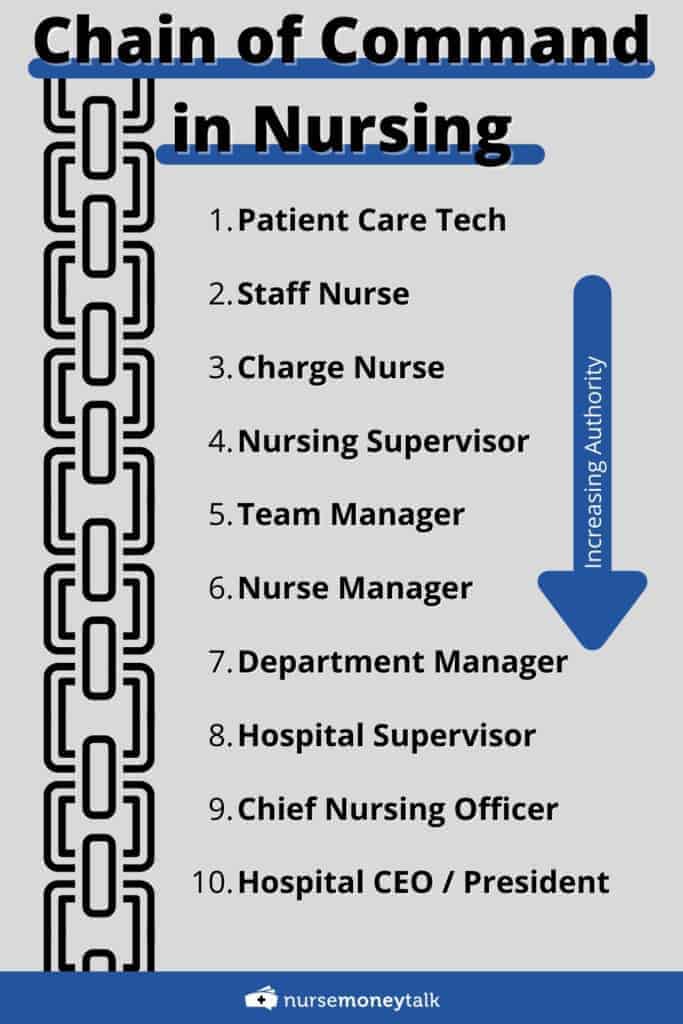The chain of command within an organization provides a helpful source of authority and responsibility for all workers.
However, health care facilities are not typical businesses, and you may be wondering if there even is a chain of command you can follow should you have a problem while working here.
*Disclosure: This article on the chain of command in nursing may contain affiliate links. If you click and make a purchase, I may receive a commission. For more info, please see my disclaimer.
Do You Have a Chain of Command as a Nurse?
There is always a chain of command that any nurse can follow should he or she have a concern about the workspace, policies, coworkers, or patient care. While lines of responsibility can quickly become blurred in health care facilities, this is particularly true in fast-paced, busy hospital settings
What Is the Chain of Command in Nursing?
This is the hierarchy of nursing leadership and authority. It typically starts with the nurse techs, to the staff nurses. It works it’s way up to the Chief Nursing Officer (CNO) and the president of the facility.
The chain of command for nurses generally falls into one of two lines depending on the concern that needs to be addressed.
Because a health care facility or hospital is a type of business that often has the goal of making money, one chain of command focuses on the board and the governing body that manages the organization.
However, most nurses are not going to deal with this chain of command in daily practice.
Instead, they have different lines of authority related to the patient care tasks with which they are most frequently involved.
In some cases, patient care managers may cross lines and work on the administrative side as well.
Related: How to Set SMART Nursing Goals
Boards, Executives and Department Heads
The head of any hospital is typically a CEO who manages much of the upper-level management positions and ensures that the system is financially healthy and growing.
However, the CEO will not usually take much interest in the minute inner-workings of daily operations at patient bedsides.
In addition, large health care organizations are further governed by a board of directors that is made up of health care experts, faculty members, or even clergy depending on the type of facility.
Areas of authority in health care facilities, including hospitals, can usually be grouped into specific categories, each of which will have its own unique structure and chain of command.
Within each of these groups, you may find an executive or department head with individuals reporting directly to him and many other people working below these managers.
Although smaller hospitals may not have as many categories, the ones most commonly seen are the following:
- Administrative
- Information
- Finance
- Diagnostics
- Therapeutics
- Support
You can learn more about the basics of hospital organization by watching this short video below.
Patient Care Managers and Medical Teams
While all of this information about CEOs and boards of directors may be interesting, it will probably not affect you too much in your daily work as a nurse.
Instead, if you are a bedside nurse, you will find yourself dealing mainly with the chain of command within the therapeutic services department.
As a service provider within the field of nursing, you will not ultimately answer to doctors but to the department of nursing within your organization.
For example, if you are a bedside nurse, your chain of command could look something like the following:

- Patient care tech (nurse aide)
- Staff nurse
- Charge nurse
- Shift manager or house supervisor
- Nurse manager
- Department manager
- Hospital supervisor
- Medical director
- Chief operations officer
Please Note:
Different facilities may have names for different positions.
For example, a charge nurse may be called a lead nurse. A house supervisor maybe called an RN administrative supervisor and a shift manager maybe called a team manager.
Either way, it’s important you learn what your facilities chain of command is since it may differ from this list.
You will rarely if ever need to go higher than your department manager, and many issues that arise can be dealt with by a shift manager or the nurse manager assigned to your floor.
Exceptions to the Chain of Command
In the field of nursing, there are almost always exceptions to every rule as emergencies and surprises frequently arise. This can also be true of the chain of command.
In an emergency scenario, the typical chain of command may fly out the window, and you may suddenly find someone else in charge.
For example, during a patient code, one doctor or even a charge nurse whom you have never met may suddenly be telling you what to do with your patient.
A viral outbreak or major incident in the hospital or community could put the facility on full alert and one department or physician in charge of all operations until the situation resolves.
Related: 10 Important Qualities of a Good Charge Nurse
Utilizing the Chain of Command in Real Time
Talking about the chain of command in a health care facility is easy to do, but following it may not be so simply accomplished.
It may be difficult to go directly to the manager above you if he or she is not an understanding individual.
You may not know what to do if a physician suddenly tells you to provide a level of care that you know is not right for your patient.
It typically requires critical thinking skills and the courage to follow this chain correctly. Here is how that might look for you.
If you have a concern with one of your patients, your first step would be to go to the physician in charge of that patient.
Ultimately, that physician is responsible for the care provided to his patient, but you are responsible for every aspect of the care you personally provide.
If you feel that the physician is not listening to your concerns, you would then need to follow your nursing chain of command, which would include reporting the perceived problem to your charge nurse and shift manager.
Sometimes, a charge nurse will be able to use his or her position to your advantage by speeding up a response time.
Your organization’s policies and procedures manual may actually stipulate certain instances when you need to involve the chain of command.
For example, these could include the following:
- The physician is not quickly providing care for a patient whose health condition is deteriorating.
- Care providers are acting unprofessionally.
- The nurse disagrees with major aspects of the physician’s patient assessment.
- A coworker seems to be working while impaired.
- A physician is not respecting a patient’s end-of-life wishes.
On the other hand, if you have a problem with a coworker, you will not involve physicians at all as they are not direct links in your chain of command.
Instead, you will go to your charge nurse if the problem is an imminent one threatening the current shift.
However, in most cases, misunderstandings, hard feelings, and personal issues can wait for a few hours to a few days, giving you time to bring your problem to the nurse manager in charge of your unit.
From there, either the nurse manager will take care of the problem, or he or she will continue bringing the issue up the chain of command until it is resolved to your satisfaction.
Pro Tip
It’s important to note that you should try to follow this chain of command whenever possible.
Too many times I’ve seen nurses skip the chain of command only to have it come back on them later for skipping the chain of command.
How the Organizational Chain of Command Benefits You and Your Patients
Following levels of authority throughout your organization may seem as if it is a colossal waste of time for some issues you believe you could solve adequately on your own in far less time.
However, these chains of command include a series of checks and balances to ensure that problems are addressed thoroughly and accurately.
They can even take some of the heat off you.
Plus, as I have learned, if you’re the one perceived to be in the wrong, chatting with a nurse manager rather than with the wronged coworker can get the truth into the open far more quickly and ensure there are no hard feelings between you and those you work with every day.
In addition, your commitment to following this chain of command can actually benefit your patients by protecting their health and ensuring they receive the level of care that they need.
The nurse is often the primary advocate for the patient, especially if the patient’s wishes differ from those of his closest family members or if the patient is unable to communicate for himself.
This video below further explains how your commitment to following the correct chain of command can lead to better care for your patients.
Final Thoughts About Following a Chain of Command
The chain of command in any health care organization is in place to protect the organization, all of its employees and the patients for which it cares.
What experiences have you had on the job that have shaped your perception of these varying levels of authority?
Related Articles
Frequently Asked Questions
-
Who is next in the chain of command above the director of nursing in a nursing home?
Above a director of nursing is the chief nursing officer (CNO).
-
What does the chain of command do in nursing?
The chain of command tells nurses who to go to in moments when a problem arises.
-
In nursing what is the chain of command when reporting problems?
The chain of command is as such nurse aide, staff nurse, charge nurse, nurse supervisors, team managers,nurse managers, department managers, hospital supervisors, and the chief nursing officer.
-
Why is chain of command important in nursing?
The chain of command tells nurses who to go to in moments when a problem arises.
-
Why follow chain of command in nursing?
The chain of command in nursing is typically followed
-
What is the nursing hierarchy?
The nursing hierarchy is the organizational (and authority) structure specific to nurses that hospitals and other healthcare facilities use.
-
Who does a CNA report to in the chain of command?
In the chain of command a CNA reports to either a licensed practical or vocational nurse (LPN or LVN) or to a licensed registered nurses (RN)
-
What position is higher than RN?
The highest degreed position for a nurse is either the doctorate of nursing practice (DNP) or a doctor of philosophy in nursing (Phd in Nursing).
-
What is the highest position of a nurse?
The highest-paid position for a nurse is a certified registered nurse anesthetist. The highest degree position for a nurse is either the doctorate of nursing practice (DNP) or a doctor of philosophy in nursing (Ph.D. in Nursing).
-
How do you use the chain of command?
It means going to your next level of authority. For example, if you’re a nurse aide your next level of authority in the chain of command would be a licensed nurse.

